Patrick van der Smagt
Constrained Latent Action Policies for Model-Based Offline Reinforcement Learning
Nov 07, 2024Abstract:In offline reinforcement learning, a policy is learned using a static dataset in the absence of costly feedback from the environment. In contrast to the online setting, only using static datasets poses additional challenges, such as policies generating out-of-distribution samples. Model-based offline reinforcement learning methods try to overcome these by learning a model of the underlying dynamics of the environment and using it to guide policy search. It is beneficial but, with limited datasets, errors in the model and the issue of value overestimation among out-of-distribution states can worsen performance. Current model-based methods apply some notion of conservatism to the Bellman update, often implemented using uncertainty estimation derived from model ensembles. In this paper, we propose Constrained Latent Action Policies (C-LAP) which learns a generative model of the joint distribution of observations and actions. We cast policy learning as a constrained objective to always stay within the support of the latent action distribution, and use the generative capabilities of the model to impose an implicit constraint on the generated actions. Thereby eliminating the need to use additional uncertainty penalties on the Bellman update and significantly decreasing the number of gradient steps required to learn a policy. We empirically evaluate C-LAP on the D4RL and V-D4RL benchmark, and show that C-LAP is competitive to state-of-the-art methods, especially outperforming on datasets with visual observations.
Assistive AI for Augmenting Human Decision-making
Oct 18, 2024Abstract:Regulatory frameworks for the use of AI are emerging. However, they trail behind the fast-evolving malicious AI technologies that can quickly cause lasting societal damage. In response, we introduce a pioneering Assistive AI framework designed to enhance human decision-making capabilities. This framework aims to establish a trust network across various fields, especially within legal contexts, serving as a proactive complement to ongoing regulatory efforts. Central to our framework are the principles of privacy, accountability, and credibility. In our methodology, the foundation of reliability of information and information sources is built upon the ability to uphold accountability, enhance security, and protect privacy. This approach supports, filters, and potentially guides communication, thereby empowering individuals and communities to make well-informed decisions based on cutting-edge advancements in AI. Our framework uses the concept of Boards as proxies to collectively ensure that AI-assisted decisions are reliable, accountable, and in alignment with societal values and legal standards. Through a detailed exploration of our framework, including its main components, operations, and sample use cases, the paper shows how AI can assist in the complex process of decision-making while maintaining human oversight. The proposed framework not only extends regulatory landscapes but also highlights the synergy between AI technology and human judgement, underscoring the potential of AI to serve as a vital instrument in discerning reality from fiction and thus enhancing the decision-making process. Furthermore, we provide domain-specific use cases to highlight the applicability of our framework.
LIMT: Language-Informed Multi-Task Visual World Models
Jul 18, 2024Abstract:Most recent successes in robot reinforcement learning involve learning a specialized single-task agent. However, robots capable of performing multiple tasks can be much more valuable in real-world applications. Multi-task reinforcement learning can be very challenging due to the increased sample complexity and the potentially conflicting task objectives. Previous work on this topic is dominated by model-free approaches. The latter can be very sample inefficient even when learning specialized single-task agents. In this work, we focus on model-based multi-task reinforcement learning. We propose a method for learning multi-task visual world models, leveraging pre-trained language models to extract semantically meaningful task representations. These representations are used by the world model and policy to reason about task similarity in dynamics and behavior. Our results highlight the benefits of using language-driven task representations for world models and a clear advantage of model-based multi-task learning over the more common model-free paradigm.
The Shortcomings of Force-from-Motion in Robot Learning
Jul 03, 2024
Abstract:Robotic manipulation requires accurate motion and physical interaction control. However, current robot learning approaches focus on motion-centric action spaces that do not explicitly give the policy control over the interaction. In this paper, we discuss the repercussions of this choice and argue for more interaction-explicit action spaces in robot learning.
Pragmatic auditing: a pilot-driven approach for auditing Machine Learning systems
May 21, 2024



Abstract:The growing adoption and deployment of Machine Learning (ML) systems came with its share of ethical incidents and societal concerns. It also unveiled the necessity to properly audit these systems in light of ethical principles. For such a novel type of algorithmic auditing to become standard practice, two main prerequisites need to be available: A lifecycle model that is tailored towards transparency and accountability, and a principled risk assessment procedure that allows the proper scoping of the audit. Aiming to make a pragmatic step towards a wider adoption of ML auditing, we present a respective procedure that extends the AI-HLEG guidelines published by the European Commission. Our audit procedure is based on an ML lifecycle model that explicitly focuses on documentation, accountability, and quality assurance; and serves as a common ground for alignment between the auditors and the audited organisation. We describe two pilots conducted on real-world use cases from two different organisations and discuss the shortcomings of ML algorithmic auditing as well as future directions thereof.
Overcoming Knowledge Barriers: Online Imitation Learning from Observation with Pretrained World Models
Apr 29, 2024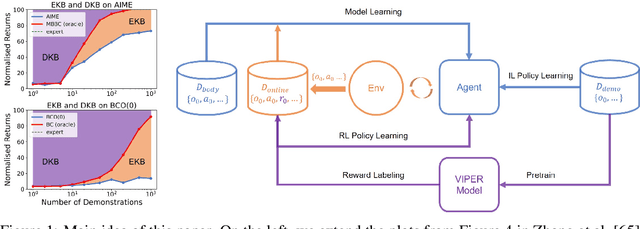
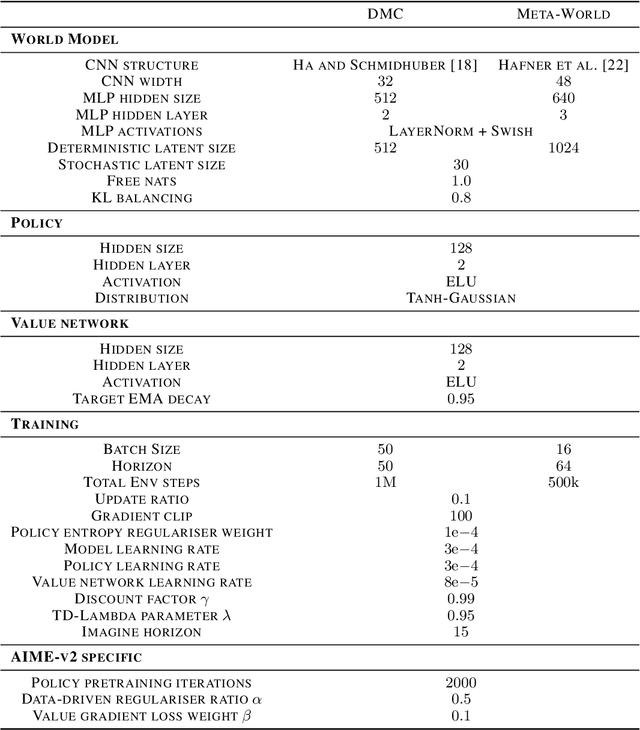
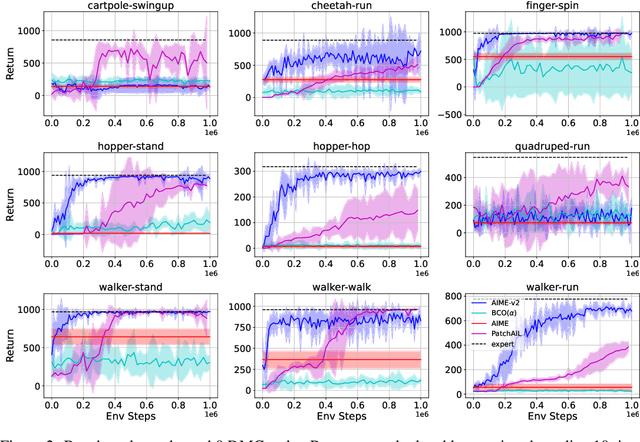
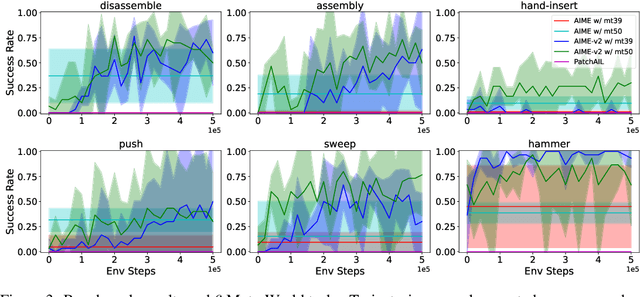
Abstract:Incorporating the successful paradigm of pretraining and finetuning from Computer Vision and Natural Language Processing into decision-making has become increasingly popular in recent years. In this paper, we study Imitation Learning from Observation with pretrained models and find existing approaches such as BCO and AIME face knowledge barriers, specifically the Embodiment Knowledge Barrier (EKB) and the Demonstration Knowledge Barrier (DKB), greatly limiting their performance. The EKB arises when pretrained models lack knowledge about unseen observations, leading to errors in action inference. The DKB results from policies trained on limited demonstrations, hindering adaptability to diverse scenarios. We thoroughly analyse the underlying mechanism of these barriers and propose AIME-v2 upon AIME as a solution. AIME-v2 uses online interactions with data-driven regulariser to alleviate the EKB and mitigates the DKB by introducing a surrogate reward function to enhance policy training. Experimental results on tasks from the DeepMind Control Suite and Meta-World benchmarks demonstrate the effectiveness of these modifications in improving both sample-efficiency and converged performance. The study contributes valuable insights into resolving knowledge barriers for enhanced decision-making in pretraining-based approaches. Code will be available at https://github.com/argmax-ai/aime-v2.
A dataset of primary nasopharyngeal carcinoma MRI with multi-modalities segmentation
Apr 04, 2024Abstract:Multi-modality magnetic resonance imaging data with various sequences facilitate the early diagnosis, tumor segmentation, and disease staging in the management of nasopharyngeal carcinoma (NPC). The lack of publicly available, comprehensive datasets limits advancements in diagnosis, treatment planning, and the development of machine learning algorithms for NPC. Addressing this critical need, we introduce the first comprehensive NPC MRI dataset, encompassing MR axial imaging of 277 primary NPC patients. This dataset includes T1-weighted, T2-weighted, and contrast-enhanced T1-weighted sequences, totaling 831 scans. In addition to the corresponding clinical data, manually annotated and labeled segmentations by experienced radiologists offer high-quality data resources from untreated primary NPC.
Guided Decoding for Robot Motion Generation and Adaption
Mar 22, 2024Abstract:We address motion generation for high-DoF robot arms in complex settings with obstacles, via points, etc. A significant advancement in this domain is achieved by integrating Learning from Demonstration (LfD) into the motion generation process. This integration facilitates rapid adaptation to new tasks and optimizes the utilization of accumulated expertise by allowing robots to learn and generalize from demonstrated trajectories. We train a transformer architecture on a large dataset of simulated trajectories. This architecture, based on a conditional variational autoencoder transformer, learns essential motion generation skills and adapts these to meet auxiliary tasks and constraints. Our auto-regressive approach enables real-time integration of feedback from the physical system, enhancing the adaptability and efficiency of motion generation. We show that our model can generate motion from initial and target points, but also that it can adapt trajectories in navigating complex tasks, including obstacle avoidance, via points, and meeting velocity and acceleration constraints, across platforms.
Sequential Model for Predicting Patient Adherence in Subcutaneous Immunotherapy for Allergic Rhinitis
Jan 23, 2024Abstract:Objective: Subcutaneous Immunotherapy (SCIT) is the long-lasting causal treatment of allergic rhinitis. How to enhance the adherence of patients to maximize the benefit of allergen immunotherapy (AIT) plays a crucial role in the management of AIT. This study aims to leverage novel machine learning models to precisely predict the risk of non-adherence of patients and related systematic symptom scores, to provide a novel approach in the management of long-term AIT. Methods: The research develops and analyzes two models, Sequential Latent Actor-Critic (SLAC) and Long Short-Term Memory (LSTM), evaluating them based on scoring and adherence prediction capabilities. Results: Excluding the biased samples at the first time step, the predictive adherence accuracy of the SLAC models is from $60\,\%$ to $72\%$, and for LSTM models, it is $66\,\%$ to $84\,\%$, varying according to the time steps. The range of Root Mean Square Error (RMSE) for SLAC models is between $0.93$ and $2.22$, while for LSTM models it is between $1.09$ and $1.77$. Notably, these RMSEs are significantly lower than the random prediction error of $4.55$. Conclusion: We creatively apply sequential models in the long-term management of SCIT with promising accuracy in the prediction of SCIT nonadherence in Allergic Rhinitis (AR) patients. While LSTM outperforms SLAC in adherence prediction, SLAC excels in score prediction for patients undergoing SCIT for AR. The state-action-based SLAC adds flexibility, presenting a novel and effective approach for managing long-term AIT.
On the Role of the Action Space in Robot Manipulation Learning and Sim-to-Real Transfer
Dec 06, 2023
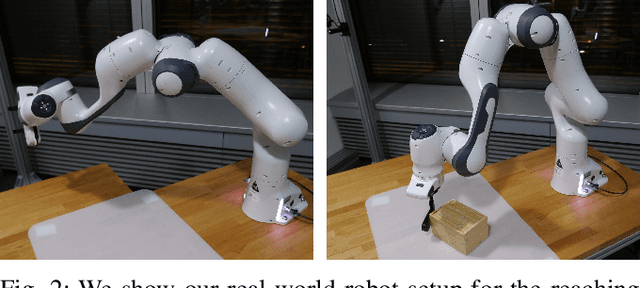
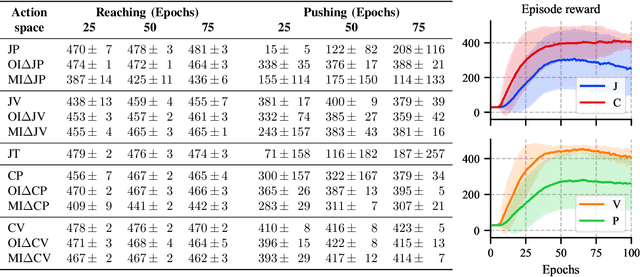
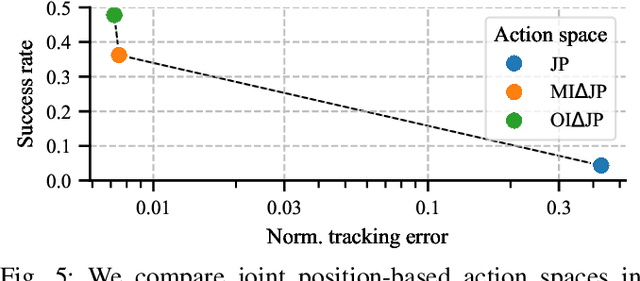
Abstract:We study the choice of action space in robot manipulation learning and sim-to-real transfer. We define metrics that assess the performance, and examine the emerging properties in the different action spaces. We train over 250 reinforcement learning~(RL) agents in simulated reaching and pushing tasks, using 13 different control spaces. The choice of action spaces spans popular choices in the literature as well as novel combinations of common design characteristics. We evaluate the training performance in simulation and the transfer to a real-world environment. We identify good and bad characteristics of robotic action spaces and make recommendations for future designs. Our findings have important implications for the design of RL algorithms for robot manipulation tasks, and highlight the need for careful consideration of action spaces when training and transferring RL agents for real-world robotics.
 Add to Chrome
Add to Chrome Add to Firefox
Add to Firefox Add to Edge
Add to Edge